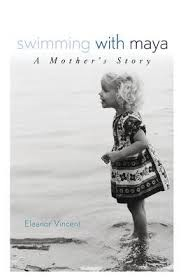In my work as a life purpose coach and journal writing facilitator, I gently guide mothers on a path through their own life story – connecting the dots of what I call “pivotal life moments.” It’s these moments that bring a deeper, richer understanding of one’s life purpose.
Adversity is a big part of the life purpose journey. How we face the more challenging parts of lives, such as sorrow and grief, paints a bigger picture of why we’re here and what we’re meant to gain in order to better understand ourselves and the world around us.
As mothers, the relationships that we have with our kids are significant. But what happens when the relationship is suddenly cut short by tragedy? How do we make sense of it – and how to we go on?
In the book, Swimming with Maya: A Mother’s Story, author Eleanor Vincent takes the reader on a personal journey through the eyes of a mother and her unconditional love for her daughter – and how her world suddenly changes when her daughter falls into a coma after being thrown by a horse. Dealing with severe brain damage, Eleanor finds herself facing difficult choices – and a goodbye that takes a heavy toll on her heart.
Losing a child is every parent’s worst nightmare. It rips through the heart like nothing else can. The grief feels unbearable.
So how does a parent find the strength to move forward? And how will they ever heal from a broken heart?
I’ve invited Eleanor to join me here today to share her story and how journal writing helped with the healing process.
************************
In my book, Swimming with Maya I recount how, as if moving through quicksand, I made it to the trauma center in Walnut Creek, a suburb of San Francisco. I sat in the ICU waiting room while Maya underwent brain surgery, and then faced my daughter’s limp body tethered to life support equipment. Throughout my nightmare, I had one anchor: my journal.
When I read those pages now, I see how divorced from reality I was. I recorded my belief that, against all odds, Maya would live. I sketched out plans for how she would learn to walk and talk again.
After a four-day vigil at her bedside, Maya was declared brain dead on April 6. My journal was where I wrote my grief, as well as recorded the moments of grace when I felt Maya at my side during the days leading up to her burial and memorial service.
I described my numb state of shock, and the searing pain when the shock wore off. I wrote about my suicidal impulses, and my determination to live and heal, mostly because my 11-year-old daughter Meghan needed me. In those early months, when my overwhelming desire was to be with Maya, the journal was a safe place to record my insanity.
And it was the witness to my gradual recovery. Of course many people played an important role in my healing, but it was the journal I trusted never to judge me or be frightened of my intense emotions. With other people, I had to pretend.
In Swimming with Maya, I describe how crazy and unmoored I felt during the early months and years of grief. Many of those descriptions began as journal entries. As I was writing the book, I read journals that were decades old in order to research, recollect, and create scenes for the book.
My book, and my recovery, were conceived and created in the pages of my journals. Words make things real for me. Writing allows me to process complex emotions in the privacy of my journal’s lined pages. Grieving for Maya was the hardest work I’ve ever done, and my journal was my companion through those long years.
Today my journal pages are filled with celebration: of my two granddaughters, accounts of time spent with Meghan and her husband, or with friends. Of course, I still use those pages to work out inner conflicts. The journal is the raw material of my life and my writing. I cannot imagine living without it.
What stories do you tell your journal before entrusting them to another person? Do you use your journal for healing? I believe that to live and write well, our journals are an essential tool.
*********

